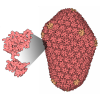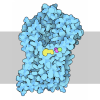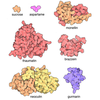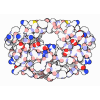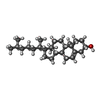+ Open data
Open data
- Basic information
Basic information
| Entry | Database: PDB / ID: 8yu7 | |||||||||||||||||||||
|---|---|---|---|---|---|---|---|---|---|---|---|---|---|---|---|---|---|---|---|---|---|---|
| Title | Cryo-EM structure of CXCR4 tetramer | |||||||||||||||||||||
 Components Components | C-X-C chemokine receptor type 4 | |||||||||||||||||||||
 Keywords Keywords | MEMBRANE PROTEIN / Chemokine receptor / CXCR4 / G protein-coupled receptor | |||||||||||||||||||||
| Function / homology |  Function and homology information Function and homology informationC-X-C motif chemokine 12 receptor activity / positive regulation of macrophage migration inhibitory factor signaling pathway / Specification of primordial germ cells / CXCL12-activated CXCR4 signaling pathway / myosin light chain binding / myelin maintenance / C-X-C chemokine receptor activity / positive regulation of vasculature development / Signaling by ROBO receptors / regulation of chemotaxis ...C-X-C motif chemokine 12 receptor activity / positive regulation of macrophage migration inhibitory factor signaling pathway / Specification of primordial germ cells / CXCL12-activated CXCR4 signaling pathway / myosin light chain binding / myelin maintenance / C-X-C chemokine receptor activity / positive regulation of vasculature development / Signaling by ROBO receptors / regulation of chemotaxis / Formation of definitive endoderm / C-C chemokine receptor activity / Developmental Lineage of Pancreatic Acinar Cells / C-C chemokine binding / Chemokine receptors bind chemokines / anchoring junction / dendritic cell chemotaxis / cellular response to cytokine stimulus / cell leading edge / positive regulation of oligodendrocyte differentiation / Binding and entry of HIV virion / regulation of cell adhesion / coreceptor activity / neurogenesis / ubiquitin binding / cell chemotaxis / calcium-mediated signaling / G protein-coupled receptor activity / brain development / response to virus / late endosome / positive regulation of cold-induced thermogenesis / actin binding / positive regulation of cytosolic calcium ion concentration / virus receptor activity / cytoplasmic vesicle / G alpha (i) signalling events / early endosome / response to hypoxia / lysosome / immune response / positive regulation of cell migration / G protein-coupled receptor signaling pathway / inflammatory response / external side of plasma membrane / apoptotic process / ubiquitin protein ligase binding / cell surface / protein-containing complex / extracellular exosome / plasma membrane / cytoplasm Similarity search - Function | |||||||||||||||||||||
| Biological species |  Homo sapiens (human) Homo sapiens (human) | |||||||||||||||||||||
| Method | ELECTRON MICROSCOPY / single particle reconstruction / cryo EM / Resolution: 3.01 Å | |||||||||||||||||||||
 Authors Authors | Liu, A. / Liu, Y. | |||||||||||||||||||||
| Funding support | 1items
| |||||||||||||||||||||
 Citation Citation |  Journal: Cell Rep / Year: 2025 Journal: Cell Rep / Year: 2025Title: Structural basis of CXCR4 assembly and regulation. Authors: Aijun Liu / Yezhou Liu / Richard D Ye /  Abstract: CXC chemokine receptor 4 (CXCR4) is a well-established drug target and a key representative of the chemokine receptor family. Chemokine receptors tend to assemble, and this assembly plays a critical ...CXC chemokine receptor 4 (CXCR4) is a well-established drug target and a key representative of the chemokine receptor family. Chemokine receptors tend to assemble, and this assembly plays a critical role in regulating their functions. However, structural information regarding the organization of these receptors remains limited. Here, we present the cryoelectron microscopy (cryo-EM) structure of a CXCR4 homo-tetramer. In this tetramer, each protomer interfaces with adjacent protomers via TM1/2 and TM5/6/7, aligning at a 90° angle to assemble into a C4 rotationally symmetric arrangement. Each protomer allosterically regulates the others, with Q272 in the ECL3 loop interacting with K38 (TM1) and V99 (TM2) of the adjacent protomer, resulting in a mutually inhibitory configuration. These findings reveal an allosteric and antagonistic mechanism that prevents excessive activation, providing a structural framework for understanding the molecular mechanisms driving CXCR4 self-assembly and offering insights that could inspire further therapeutic strategies. | |||||||||||||||||||||
| History |
|
- Structure visualization
Structure visualization
| Structure viewer | Molecule:  Molmil Molmil Jmol/JSmol Jmol/JSmol |
|---|
- Downloads & links
Downloads & links
- Download
Download
| PDBx/mmCIF format |  8yu7.cif.gz 8yu7.cif.gz | 213.3 KB | Display |  PDBx/mmCIF format PDBx/mmCIF format |
|---|---|---|---|---|
| PDB format |  pdb8yu7.ent.gz pdb8yu7.ent.gz | 175.6 KB | Display |  PDB format PDB format |
| PDBx/mmJSON format |  8yu7.json.gz 8yu7.json.gz | Tree view |  PDBx/mmJSON format PDBx/mmJSON format | |
| Others |  Other downloads Other downloads |
-Validation report
| Summary document |  8yu7_validation.pdf.gz 8yu7_validation.pdf.gz | 2.2 MB | Display |  wwPDB validaton report wwPDB validaton report |
|---|---|---|---|---|
| Full document |  8yu7_full_validation.pdf.gz 8yu7_full_validation.pdf.gz | 2.3 MB | Display | |
| Data in XML |  8yu7_validation.xml.gz 8yu7_validation.xml.gz | 53.1 KB | Display | |
| Data in CIF |  8yu7_validation.cif.gz 8yu7_validation.cif.gz | 66.6 KB | Display | |
| Arichive directory |  https://data.pdbj.org/pub/pdb/validation_reports/yu/8yu7 https://data.pdbj.org/pub/pdb/validation_reports/yu/8yu7 ftp://data.pdbj.org/pub/pdb/validation_reports/yu/8yu7 ftp://data.pdbj.org/pub/pdb/validation_reports/yu/8yu7 | HTTPS FTP |
-Related structure data
| Related structure data |  39573MC M: map data used to model this data C: citing same article ( |
|---|---|
| Similar structure data | Similarity search - Function & homology  F&H Search F&H Search |
- Links
Links
- Assembly
Assembly
| Deposited unit | 
|
|---|---|
| 1 |
|
- Components
Components
| #1: Protein | Mass: 39656.199 Da / Num. of mol.: 4 Source method: isolated from a genetically manipulated source Source: (gene. exp.)  Homo sapiens (human) / Gene: CXCR4 / Production host: Homo sapiens (human) / Gene: CXCR4 / Production host:  #2: Chemical | ChemComp-CLR / Has ligand of interest | N | Has protein modification | Y | |
|---|
-Experimental details
-Experiment
| Experiment | Method: ELECTRON MICROSCOPY |
|---|---|
| EM experiment | Aggregation state: PARTICLE / 3D reconstruction method: single particle reconstruction |
- Sample preparation
Sample preparation
| Component | Name: Tetramer of CXC Chemokine Receptor type 4 / Type: COMPLEX / Entity ID: #1 / Source: RECOMBINANT |
|---|---|
| Source (natural) | Organism:  Homo sapiens (human) Homo sapiens (human) |
| Source (recombinant) | Organism:  |
| Buffer solution | pH: 7.4 |
| Specimen | Embedding applied: NO / Shadowing applied: NO / Staining applied: NO / Vitrification applied: YES |
| Vitrification | Cryogen name: ETHANE |
- Electron microscopy imaging
Electron microscopy imaging
| Experimental equipment |  Model: Titan Krios / Image courtesy: FEI Company |
|---|---|
| Microscopy | Model: FEI TITAN KRIOS |
| Electron gun | Electron source:  FIELD EMISSION GUN / Accelerating voltage: 300 kV / Illumination mode: FLOOD BEAM FIELD EMISSION GUN / Accelerating voltage: 300 kV / Illumination mode: FLOOD BEAM |
| Electron lens | Mode: BRIGHT FIELD / Nominal defocus max: 2500 nm / Nominal defocus min: 1200 nm |
| Image recording | Electron dose: 52 e/Å2 / Film or detector model: GATAN K3 BIOQUANTUM (6k x 4k) |
- Processing
Processing
| CTF correction | Type: PHASE FLIPPING AND AMPLITUDE CORRECTION |
|---|---|
| 3D reconstruction | Resolution: 3.01 Å / Resolution method: FSC 0.143 CUT-OFF / Num. of particles: 1626680 / Symmetry type: POINT |
 Movie
Movie Controller
Controller



 PDBj
PDBj









